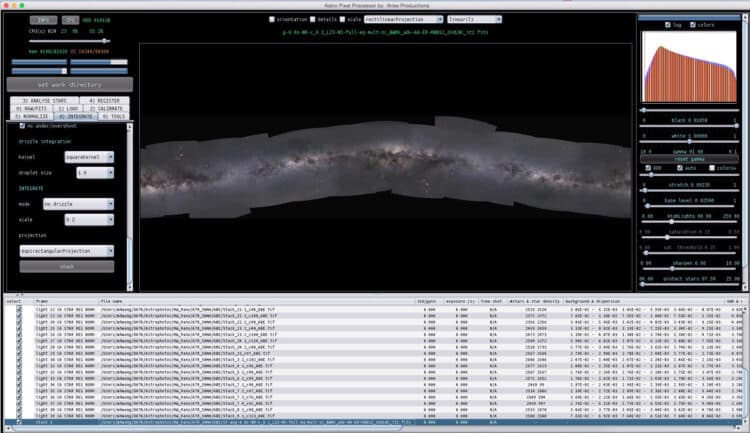You need to log in or create an account to post to this user's Wall.
-
Hi Wei-Hao (@whwang),
Thank you for explaining your thoughts and writing down this concept.
“The idea is to identify overlapping regions between two registered frames.”
I have this covered already, in both the advanced normalisation mode and LNC algorithms.
”
Suppose the pixel brightness in one frame is I1(x,y), and the other is I2(x,y). For…[Read more]
-
” Low priority
1. capability to handle images a few times larger than 700 MP. ”
Yes, something for the future, but definitely on the list
“2. To allow to use a wide-field low-resolution image as a registration reference. Such an image can even serve as a reference for sky gradient subtraction and image normalization.”
I understand,…[Read more]
-
Hi @whwang,
“I know that my Milky Way panorama is very challenging. At this moment, no any other programs can go as far as APP has. So even though the results above are not good enough yet, APP has already been far more successful than any other program. It is really wonderful to see this.”
Excellent, thank you very much for all of your co…[Read more]
-
Wang started the topic Thoughts about multiplicative+additive+nonlinear normalization in the forum
 Astro Pixel Processor Beta 6 years, 11 months ago
Astro Pixel Processor Beta 6 years, 11 months agoHi,
We talked about this in the previous thread. I think it’s better to open a new thread for this topic. The method I am going to suggest was once used in my old image processing. So it should work to certain degree.
The idea is to identify overlapping regions between two registered frames. Suppose the pixel brightness in one frame is I1(x,y),…[Read more]
-
@whwang, not yet, but it’s on my list to set logging on in APP’s configuration menu. I’am also planning to show console output while APP’s working 😉
-
Wang replied to the topic Error: java.lang.NegativeArraySizeException in the forum
 Astro Pixel Processor Beta 6 years, 11 months ago
Astro Pixel Processor Beta 6 years, 11 months agoHi Mabula,
Thanks for the reply. It is very fun to try APP and I see lot of potential.
I know that my Milky Way panorama is very challenging. At this moment, no any other programs can go as far as APP has. So even though the results above are not good enough yet, APP has already been far more successful than any other program. It is rea…[Read more]
-
Wang replied to the topic Bug report: crash after switching between screens in the forum
 Astro Pixel Processor Beta 6 years, 11 months ago
Astro Pixel Processor Beta 6 years, 11 months agoDoes APP automatically send you (or save locally) a crash report every time it is crashed or forced to terminate? It should be useful.
-
Hi @whwang,
Thank you again for your feedback.
“On the other hand, the registration is still terribly wrong. I increased the detected stars to more than 6000. Typical registration rms is between 1 and 3 and number of stars is less than half of the detected stars. For registration, I used dynamic distortion correction and calibrated projective,…[Read more]
-
Thank you @whwang,
I will test this using my macbook with attached monitors and hopefully fix this.
Added to RFC
Mabula
-
Wang replied to the topic Error: java.lang.NegativeArraySizeException in the forum
 Astro Pixel Processor Beta 6 years, 11 months ago
Astro Pixel Processor Beta 6 years, 11 months agoMore attempt. This time, the brightness/contrast different between panels seem to reduced. I had used the advanced and multiply-scale options for normalization. I am not sure whether this combination of parameters is responsible for the improvement.
On the other hand, the registration is still terribly wrong. I increased the detected stars to…[Read more]
-
Wang replied to the topic Bug report: crash after switching between screens in the forum
 Astro Pixel Processor Beta 6 years, 11 months ago
Astro Pixel Processor Beta 6 years, 11 months agoSorry. Further tests show that it has nothing to do with moving APP’s window from one monitor to the other. Even if it stays in the same window, just shutting down the other one can trigger a crash.
-
Wang started the topic Bug report: crash after switching between screens in the forum
 Astro Pixel Processor Beta 6 years, 11 months ago
Astro Pixel Processor Beta 6 years, 11 months agoI have two monitors connected to my Mac. The two have different resolutions. Dragging APP between the two monitors is OK and would not cause troubles.
On the other hand, APP would crash when I turn one monitor (the one with APP) off and the system forces APP to move to the monitor that’s on. The forced movement between monitors works totally fine…[Read more]
-
H@whwang,
Wow, that already looks pretty impressive ;-) !
“Is 32bit floating point the internal data format for APP? Does relaxing it to 16bit floating point allow for 1.4 GP images without significant rebuilt of APP?”
In image integration APP converts all image data formats to normalized 32bits float data in the range of 0-1. I have…[Read more]
-
Wang replied to the topic Error: java.lang.NegativeArraySizeException in the forum
 Astro Pixel Processor Beta 6 years, 11 months ago
Astro Pixel Processor Beta 6 years, 11 months agoHi Mabula,
Thank you. The new system warning should be very useful. 700 MP is already slightly larger than the largest mosaic that I had ever built:
http://www.astrobin.com/250543/?nc=user
Is 32bit floating point the internal data format for APP? Does relaxing it to 16bit floating point allow for 1.4 GP images without significant rebuilt of…[Read more]
-
Hi Wei-Hao (@whwang)
I have added several extra checks for memory or technical limits into APP.
A proper message will pop-up, when image dimensions become infinite or negative, like the error that started this thread.
If your image dimensions after registration become bigger than
1) the amount of memory that can be allocated or
2) the…[Read more]
-
“It still shows an out of memory error. What’s funny is that I once successfully stitched all the panels together using a computer with just 16 GB of RAM. ”
By looking at the error, I think I know what’s happening. My initial guess would be that:
After registration, APP finds a field of view that is too large too fit into the ima…[Read more]
-
“In my own data processing for large telescopes, I first subtract the background in all mosaic panels and make the background zero in all panels. This handles the additive term. Then I conduct aperture photometry on stars in the panels, and use the common stars in the overlapping region to adjust the brightness of the panels. This ha…[Read more]
-
Wang replied to the topic Error: java.lang.NegativeArraySizeException in the forum
 Astro Pixel Processor 6 years, 11 months ago
Astro Pixel Processor 6 years, 11 months agoA new kind of error message pops up. This time I tried to mosaic a subset of panels to see if I can avoid the out of memory error. Then I saw this new error message soon after I initiated the stacking procedure.
-
Wang replied to the topic Error: java.lang.NegativeArraySizeException in the forum
 Astro Pixel Processor 6 years, 11 months ago
Astro Pixel Processor 6 years, 11 months agoMore to report.
This time I used a different computer and allocated 80 GB of RAM to APP. It still shows an out of memory error. What’s funny is that I once successfully stitched all the panels together using a computer with just 16 GB of RAM. Then I couldn’t reproduce the success on the same computer and on the more RAM-rich computer: al…[Read more]
-
Wang replied to the topic Error: java.lang.NegativeArraySizeException in the forum
 Astro Pixel Processor Beta 6 years, 11 months ago
Astro Pixel Processor Beta 6 years, 11 months agoLooks like Registar can deal with both additive and multiplicative terms simultaneously. Unfortunately I have no idea how that was achieved. It can even handle images that are not linear. (It was produced during the film era.) So it may be doing more than simple multiplicative+additive calculations.
In my own data processing for large t…[Read more]
- Load More




